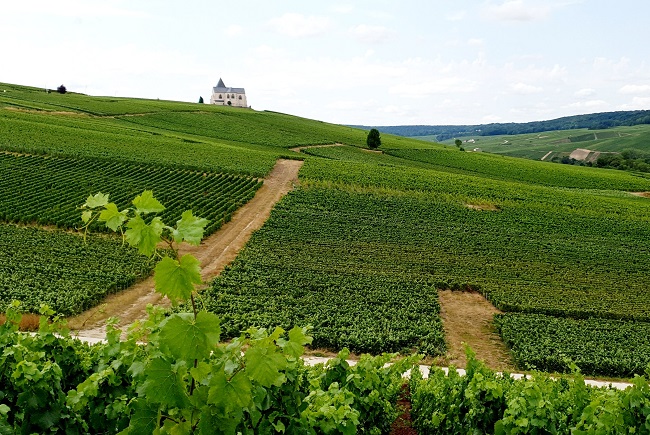Carnet de Voyage: the Champagne Guy

Travel notes from the real France. Carnet de Voyage is a weekly personal travel story in France sent in by readers. If you’d like to submit a story to Carnet de Voyage, head here for details on how to submit.

Rachel and her family drove around the north of France last summer © Rachel Ifans
It’s not a good look when your 11-year-old daughter calls on the mobile at 11pm to say she and her brother haven’t had any dinner because you said you’d be back to get them something but now you’ve been with the Champagne guy for, like, two hours [sic].
“He’s very hospitable,” your husband hisses into the phone.
“He said they could eat the ripe plums off his trees,” you hiss to your husband.
We were at the Champagne Sourdet-Diot estate in Chapelle-Monthodon, in the Aisne département. We were travelling the north of France that summer in our motorhome, researching its gastronomic might for a feature I was writing.
We had heard that some Champagne estates let motorhomers park up in their grounds for free overnight stops. That evening, having found our Plan A full, we’d rung Sourdet-Diot at a cheeky 9pm to see if it would be possible.
The welcome could not have been warmer. Patrick took the call with good grace and by the time we’d hared around the nearby lanes in a race against dusk, he’d opened the big gates so he could direct us to The Spot.
We parked up under the heaving boughs of a plum tree. Our eyes must have rolled into plum-shaped ovals like fruity one-armed-bandits because Patrick laughed and said we could take as many as we wanted.
His daughter and family were aôutiers (on holiday for the whole month of August) and there was no way he and his wife could get through the plums alone.
No sooner had I divulged my position as journalist and nosey parker, than he’d offered us a tour of the vineyard, a first-hand dive into the Champagne-making process and – ding! ding! – a tasting.
So, now you understand why we were found in the bar of an independent Champagne house at nearly midnight, trying glass after glass while our children raided the crisps and biscuits in the motorhome. From Cuvée de Reserve to Cuvée Prestige and Cuvée Rosé, we ooo-ed and ahhed at the crisp loveliness.
The Sourdet family is a new Champagne house, by Champagne’s standards. They started growing vines in the 60s and selling their grapes to the big houses like Moët Chandon, Veuve Clicquot and Trouillard. 20 years later, they started to use grapes from their 11 hectares of vineyards to produce their own champagne.
I had a feeling Patrick – now retired – was enjoying this impromptu tour just as much as us. Free rein of the estate he once ran while the kids were off on holiday… Impressing Brits with his knowledge of l’assemblage, the prise de mousse, and the turning process. Santé, Patrick, it was unforgettable.
Rachel Ifans is a travel writer who specialises in writing about France for publications like The Independent, National Geographic, Rough Guides, Adventure.com and more. Cartes Postales are her postcards from France. They’re short dips into everything French… memories, culture, society, books, films, but mostly travel. Subscribe to receive her free postcards.

Everything you need to know about making Champagne © Deleece Cook on Unsplash
Champagne 101
There are four Champagne regions: Reims, Troyes, Champagne-Ardennes and lastly the Marne valley, which falls in the Aisne region, part of Hauts-de-France.
The Marne valley runs between Epernay and Chateau Thierry and is the least known of the four regions. Now I’m sure most of you francophiles are au fait with the Champagne-making process, but I wasn’t before I stopped overnight with Patrick… so here’s what he told me.
Champagnes are made from a mix of Pinot Noir, Pinot Meunier and Chardonnay grapes and although the ingredients are a fairly simple matter, the art – and time and effort – of making good bubbly is what brings about the hefty price tags.
- You need over a kilogram of grapes to make a bottle of Champagne and these grapes must be picked by hand.
- The grapes are pressed using a machine which, according to Patrick, cost €90,000 and is in use for just 10 days per year!
- Next comes the first fermentation, which takes between 10 and 18 days, at which point l’assemblage takes place. This is when the varieties and quantities of grapes are blended.
- At this stage, the wine is still flat; it needs to be fermented a second time in order for the prise de mousse – the bubbles! – to occur.
- After the second fermentation, the Champagne is aged, for anything from 15 months to 10 years or more.
- After ageing, the process of turning begins. Turning the bottles gradually works the sediment to the neck of the bottle, where it can be frozen and popped out of the top before a cork is inserted. While the sediment is in the bottle, the wine keeps improving but once removed, the Champagne starts to degrade and must be drunk within three years.
- A mix of reserve wine and sugar – called liqueur de dosage – is then added to the bottle and it’s shaken to mix before resting for a few months. Phew!
Lead photo credit : The Champagne-producing area covers several regions in France © Fernand Champagne on Unsplash
Share to: Facebook Twitter LinkedIn Email
More in Carnet de Voyage, champagne, Champagne region, vineyards
By Rachel Ifans
Leave a reply
Your email address will not be published. Required fields are marked *



